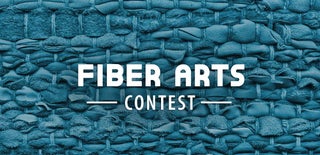Introduction: Discover Punch Needle: Significant Otter Design
Punch needle is getting a revival in the yarn crafts world. It is a technique that lies halfway between embroidery and rug-making, with patterns varying from very abstract to very detailed; using a range of threads from thick yarn to embroidery floss.
In this tutorial, we explore the technique of needle punching on a small embroidery hoop and with a fine needle. Although this discipline can surface some frustrations, it is mostly a therapeutic craft, and the few tips that follow will hopefully leave you wanting for more.
Here you will find beginner tips needed to create your own punch needle designs; you may also prefer to follow along and use the sweet "Significant Otter" pattern provided in Step 1.
Supplies
- a 10cm diameter embroidery hoop
- embroidery thread in light blue, red, black, and 3 shades of brown (or whichever colours your design calls for)
- a 1.3mm adjustable punch needle; the one used here is from Rico
- scrap fabric, thick enough to catch the thread (denim is used in this example)
- fray stop
- scissors, pen or fabric marker, paper, tracing paper
Step 1: Create Your Design
Using pen and paper, trace the inner hoop. This will create your workable area.
It is worth noting, for punch needle designs, that you will prefer geometric shapes, or solid colour areas, as very small details can get lost among the loops.
One you're done, proceed to the next step.
Alternatively, download and print the Significant Otter design file provided below.
Attachments
Step 2: Prepare Your Hoop
Add your scrap fabric to the embroidery hoop; you will want the fabric to be quite thick, so it can catch the thread and create neat loops. Keep the fabric taut, and re-tighten it as you go along (punching tends to make it a bit slack.)
Transfer your design with a fabric marker, either by cutting it out, using tracing paper, or - if you have a projector - projecting it onto the fabric.
Next, thread your punch needle tool with 2 strands of black embroidery floss and read the punch needle tips that follow.
Note: if too thick, there is a chance that the thread will stay caught in the needle and will stop the loops forming, hindering any progress. Always test the thickness of thread for your size needle in a small area of the hoop. This can be unravelled before starting the actual design.
Step 3: Punch Needle Tips
Punch needle effects
There are 2 ways, and 2 effects you can get with punch needles.
A common one is to work on the wrong side of the fabric to create a dense loop effect on the right side. The effect can also vary depending on the length of the loop. The other, is to work in continuous stitches, that will look similar to embroidered back-stitches. In that case, start by outlining the shape you wish to fill in and work around toward the centre.
How to work
To start punching, thread the tool with a needle threader: first through the pen, then through the eye of the needle. Then, pierce the fabric and grab the end of the thread coming from the eye of the needle. You can adjust the amount by pulling the other end of the thread, coming out of the top of the punch needle (watch out, you don't want to pull too much and unthread it!).
Then, carefully pull up the pen, brush the surface of the fabric, and punch again. Repeat the process, creating loops on the underside of the fabric. Always work with the big hole of the needle facing the direction of progress.
Be careful not to hold the hoop too close to yourself and get accidentally stabbed, these tools are sharp!
Tips & fixes
Do not pull the needle off the fabric too much, you might cause some unravelling. If that's the case, lift the punch needle vertically back to the last secure stitch and gently pull the thread coming out of the top until the needle touches the fabric. Resume punching from there.
If you have created holes in the fabric due to unravelling, gently rub the area between your fingers until they disappear. This will make the fabric "catchy" again and prevent stitches from getting undone.
Once you've worked a thread, trim the extremities to match the loop length, particularly if working loops on the right side.
Step 4: Design Contour
As we've just seen in the tips, there are 2 ways, and 2 different effects we can get with punch needle. This design uses a mix of both.
The otter contour and heart will use the straight stitch while the inside area will take advantage of the loops to make a fluffy otter.
Start by evenly contouring in black. Remember to alway have the large hole of the needle facing in the direction of progress. It can help to turn the whole hoop as you go along and view your progress sideways.
Once the otter is done, thread 2 strands of red and fill the heart. Start by tracing its outline, and fill it in by going around the inside until you reach the centre.
Step 5: Filling In
To fill the colours in, we'll punch on the wrong side of the fabric, creating loops on the right side. If you have an adjustable punch needle, you can vary the loop length for each colour. For the otter, we'll break them down as follows:
- head and under feet: light brown/beige
- body: brown
- tail: dark brown
Because we're using such fine thread, it is likely that we'll have to go over stitches multiple times on the wrong side, to create more loops on the front. If you wish to prevent your fabric from showing through the gaps, we'd recommend painting the areas with brown fabric paint first.
To fill the colour in, start by contouring the area you want to fill on the wrong side, checking that you're not crossing the black outlines on the front. Then, work around the inside of the area towards the centre. Check the amount of loops on the right side and repeat as needed, starting from the outline.
When your otter is filled in, check the right side to see if the black outlines are still visible. If need be, go over them again with a longer stitch setting (particularly for face, arms, and legs details).
Step 6: Writing
The writing will be done on the right side of the fabric. If you haven't transferred the word onto the hoop in the preparation stage, do so now.
We'll punch "Significant" in light blue to mimic the water our otter might be drifting in. If you're following your own design and wish to incorporate writing, make sure you pick a typeface where letters are connected, to make it easier to punch in one go.
Before you start, figure out which is the best path to take to avoid cutting thread between letters; it could mean starting at the end. In this example, we start at the top of the "S", all the way up to the tail, and double-up the thread until the middle, where the leg of the "i" starts, and follow along until the end of the "t", omitting the dots on the "i"s.
If you prefer, this stage can also be embroidered using a back-stitch.
Dot the eyes with French knots (three wraps around the needle should make them thick enough).
Step 7: Finishing Off
To secure your stitches, add some fray stop to the back of the hoop, particularly where threads stop and start. Try to also block some loops from the contour and and writing. Let it dry.
Finish the hoop as you would other embroidery projects: you might wish to stitch the excess fabric and add a backing, or cut the edges and fold the fabric on the inside of the hoop, securing it with a hot glue gun. The finishing method is really up to you.
Add a string or ribbon at the top, and your first punch needle design is ready to hang proudly on your wall!
Please share your makes in the comments, I'd love to see what designs you come up with.

Runner Up in the
Fiber Arts Contest














